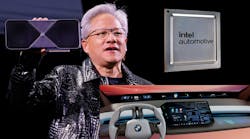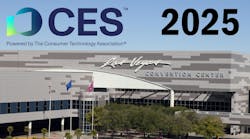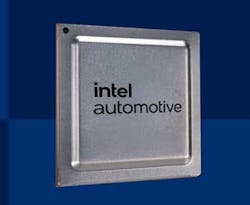Vehicle Tech at CES 2025: From SDVs to Windshield Widgets
What you’ll learn:
- Toyota Motor will have automated-driving capabilities powered by NVIDIA’s DRIVE AGX Orin running DriveOS.
- Intel’s new ACU U310 processing unit supports the consolidation of multiple real-time, safety-critical and cybersecure functions, applications, and domains (X-in-1) into a single chip.
- BMW’s Panoramic Vision projects information across the entire width of the windscreen.
When it comes to consumer electronics, CES is the industry’s Olympics. This year, in the automotive event, three exhibitors in particular were vying to win a gold medal: NVIDIA, BMW, and Intel.
NVIDIA is unquestionably the Big Kahuna in AI and accelerated computing solutions for automotive. But as any gunslinger in the Wild West could tell you, it’s easier to become number one than to stay that way.
“The autonomous vehicle revolution has arrived, and automotive will be one of the largest AI and robotics industries,” said Jensen Huang, founder and CEO of NVIDIA. During his opening keynote at CES, Huang announced that Japan's Toyota Motor, the world's largest car manufacturer, will have automated driving capabilities powered by NVIDIA’s DRIVE AGX Orin running DriveOS in upcoming models of its cars.
NVIDIA offers three core computing systems and the AI software needed for autonomous-vehicle (AV) development. Its DRIVE AGX is the in-vehicle computer, DGX trains AI models and software stacks, and the Omniverse platform tests and validates self-driving systems in simulation.
Huang revealed the Toyota deal as part of what it calls its "Cosmos" set of AI technologies. Cosmos includes AI models for devices that have to move in the physical world, including robots and automobiles. Cosmos, which will be made available on an "open license," works with NVIDIA's physics simulation tool, Omniverse. Omniverse generates simulations and Cosmos turns that into photorealistic video imagery to train robots and automobiles at a lower cost than using conventional video data, which is typically gathered by putting cars on the road.
Toyota will also use NVIDIA’s DGX computers, which it has employed in the past to train artificial-intelligence models for self-driving vehicles. The latest version of the AGX chip, H, is called the "Thor AGX." It’s said to be 20X more powerful than its predecessor Orin model.
Slated to be available in production vehicles later this year, DRIVE AGX Thor is a centralized compute system built on the NVIDIA Blackwell architecture. It’s the first solution to use Arm Neoverse V3AE, Arm’s first Neoverse CPU enhanced for automotive applications. Neoverse V3AE was launched in March 2024 as part of a series of industry firsts, including introducing Armv9-based technologies to the automotive market.
Another announcement at CES 2025 concerned AV technology startup Aurora Innovation’s and automotive supplier Continental’s long-term partnership with NVIDIA to deploy driverless trucks powered by the Thor SoC. NVIDIA’s accelerated compute running DriveOS will be integrated into the Aurora Driver, an SAE level 4 autonomous-driving system that Continental plans to mass-manufacture in 2027.
>>Check out more of our CES 2025 coverage
Widgets on the Windshield
The launch of the Neue Klasse vehicles in late 2025 marks a next step for the BMW Group. In late 2025, the new BMW Panoramic iDrive (Fig. 1) will make its way into all new BMW models, regardless of drive system type. The software behind the new BMW Panoramic iDrive is the BMW Operating System X.
The central interface for driver-vehicle interaction consists of four key components: the BMW Panoramic Vision, the Central Display, a new multifunction steering wheel, and the new, optional BMW 3D Head-Up Display.
The BMW Panoramic Vision projects information across the entire width of the windscreen, allowing the driver and occupants to experience an entirely new dimension of personable content. The Central Display gets its unique color and luminosity from the company’s Matrix Backlight technology—in any light conditions. And for the first time, the BMW 3D Head-Up Display offers an even broader overview by projecting the navigation and assisted-driving displays straight into the driver’s field of vision.
Rounding off the BMW Panoramic iDrive ensemble is a new multifunction steering wheel with haptic feedback. The software underpinning the display and operating concept of the BMW Panoramic iDrive is the BMW Operating System X.
Like its predecessors, the BMW Operating System X is based on an Android Open Source Project (AOSP) software stack. Developed in-house, it fully and seamlessly integrates third-party apps in streaming, gaming, and infotainment.
Innovation Using a Whole-Vehicle Approach
At CES, Intel unveiled an expanded product portfolio and new partnerships designed to accelerate automakers’ transitions to electric and software-defined vehicles (SDVs). The company now offers a whole-vehicle platform, including high-performance compute, discrete graphics, artificial intelligence (AI), power management, and zonal controller solutions alongside its Automotive Virtual Development Environment (VDE) co-developed with Amazon Web Services (AWS).
Jack Weast, Intel Fellow, vice president, and general manager of Intel Automotive, said, “Intel automotive is bringing innovative solutions that reduce cost in the SDV revolution. Our whole-vehicle approach, combined with cloud integration, delivers a complete solution that drives down total cost of development and deployment while empowering automakers to build the future of mobility faster, more efficiently and more profitably.”
Intel’s whole-vehicle platform is said to reduce the inefficiencies of traditional fragmented approaches to vehicle architectures. Supporting this platform, Intel introduced the Adaptive Control Unit (ACU), designed for electric-vehicle (EV) powertrains and zonal controller applications.
The ACU U310 processing unit supports the consolidation of multiple real-time, safety-critical and cybersecure functions, applications, and domains (X-in-1) into a single chip (Fig. 2).
Traditional time and sequential processing-based micro and zonal controllers struggle to handle multiple workloads due to limited deterministic processing capabilities. In contrast, Intel’s new family of ACU devices integrates a flexible logic area that offloads real-time control algorithms from the CPU cores. This ensures reliable performance, freedom from interference (FFI), and deterministic data delivery even when consolidating multiple microcontroller workloads into a single zonal MCU. According to Intel this dual-brain approach enables greater workload consolidation, lowers cost, and enhances safety, cybersecurity, and performance.
When used in an EV powertrain, the ACU U310 supports algorithmic solutions that reduce vehicle energy demand from the battery, automatically adapting high voltage and control frequencies to individual driver styles and road conditions.
According to Intel, the ACU reduces cost per kilowatt and enhances energy efficiency, allowing for the vehicle to reclaim up to 40% of the powertrain system energy losses, delivering a 3% to 5% efficiency boost during the Worldwide Harmonized Light Vehicles Test Procedure (WLTP). This translates to increased range, faster charging, and a more responsive driving experience while significantly reducing per-vehicle bill of materials (BOM), electric motor size, and battery costs compared to traditional approaches.
Stellantis Motorsports is adopting the Adaptive Control technology into its next-generation inverter control. In this implementation, the Intel technology will control the electric motor and recover energy during braking phases. The inverter plays a crucial role during a Formula E race, where any gain in efficiency transforms into a precious competitive advantage.
Karma Automotive announced support for Intel’s ACU, showcasing an Intel co-branded inverter featuring Optimal Pulse Pattern control algorithms to improve efficiency and enable four unique driving profiles. Features include Torque Ripple Reduction and Range Boost.
The ACU’s programmability enables it to serve as a first-of-its-kind software-defined zonal controller, adapting to different vehicle topologies and applications. This flexibility streamlines the transition to software-defined vehicles, simplifies supply chains, and reduces the complexity of the vehicle BOM.
AI Inside
Also at CES, Intel, building on its first-generation AI-enhanced SDV system-on-chips (SoCs), announced the upcoming second-generation Arc B-series Graphics for Automotive set for production by the end of 2025. This solution provides the high-performance computing needed for more advanced in-vehicle AI workloads, next-generation human-machine interface (HMI) engines, and immersive in-vehicle experiences.
Paired with an Intel AI-enhanced SDV SoC and supported by the Intel AI ecosystem, the platform is said to deliver scalable performance for complex AI tasks.



